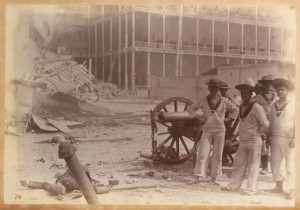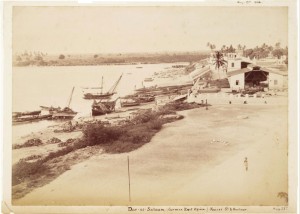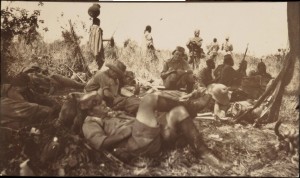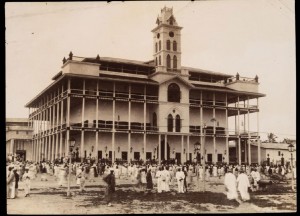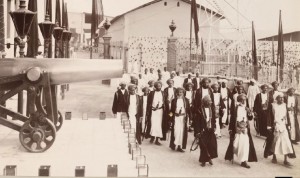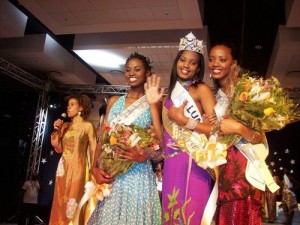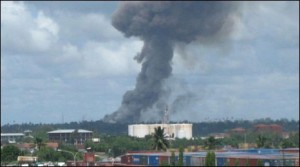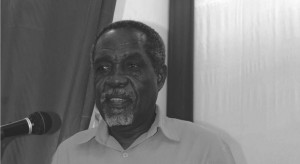Edited by John Cooper-Poole (UK) and Marion Doro (USA)
SURROGATES OF THE STATE: NGOS, DEVELOPMENT, AND UJAMAA IN TANZANIA, by Michael Jennings. Kumarian Press, Danvers MA, 2007. xxi + 243. $50.00 (cloth). ISBN 978-1-56549-243-1.
In this most readable book, Michael Jennings offers an important case study of Oxfam in Tanzania during the two decades following independence. His method is not to recreate policy debates and shifts, but rather to examine ‘how NGOs were shaped by the periphery: from the projects and programs they ran in the field; and through interaction with Southern governments, citizens, and partners’ (p. 3). This book also offers a study of the development industry and its ideals during the 1960s and 1970s. While not prescriptive in its conclusions, Jennings does offer a number of insights that the NGO sector – notorious for its chronic failures of institutional memory – may find useful.
The book begins with an overview of NGOs and a history of charitable institutions in sub-Saharan Africa. Jennings stresses the historical role of informal networks to Africans’ welfare and survival, as well as the dual origins of NGOs in both nineteenth-century missionary organizations and the larger ‘development’ projects of the post-Second World War period. The book’s first full chapter examines Tanzania’s post-colonial rural development policy. Although it makes strangely little reference to the preceding colonial period, this chapter does show how resettlement and agricultural transformation policies consistently guided state intervention throughout the 1960s and 1970s, rather than emerging only with Nyerere’s dramatic pronouncements on the subject. There is also a useful, if not definitive, account of villagization in these pages, as well as a narrative of increasing ‘statism’ on the part of the Tanzanian government into the lives of its citizens and civil society.
The following five chapters, the core of the book, demonstrate how the Tanzanian state created ‘willing surrogates’ among NGOs and local agencies, acting not as independent actors but ‘as another phalanx in the development front’ (p. 92) during the 1960s and 1970s. The state had come to fully exercise this domination by the late 1960s, most plainly in seizing control of the actions of faith-based organizations. Jennings shows how the Christian Council of Tanzania (CCT), a Protestant umbrella group, came to embrace villagization with its ‘lure of increased control over its flock’ (p. 86). Churches uncomfortable with socialism simply defined ujamaa in Christian terms. The book’s centrepiece is its analysis of the activities of one key NGO, Oxfam, during the 1960s and 1970s. Oxfam was then and remains today the UK’s largest NGO; it found in ujamaa all of the ideals – community participation, poverty alleviation, and struggle against inequality – that it valued most. Yet while Tanzania came superficially to resemble many Oxfam ideals, it was ‘in reality implementing a system of rural control that deliberately sought to undermine local, grassroots control’ (p. 122). Using Oxfam archival sources, Jennings paints a picture of an institution that frankly should have known better, as it followed the state down the path of villagization during the 1970s with little critical reflection. Yet while managing to show Oxfam’s complicity in these developments, Jennings does not make clear the scale and scope of the ‘atrocities’ (p. 135) carried out during villagization – a subject of great and unsettled debate. He does, however, demonstrate Oxfam’s central role in many ujamaa dramas, such as the life and death of the Ruvuma Development Association, which revealed the limits of Oxfam’s lobbying powers as well as its subsequent capacity for self-deception. By the end of the 1970s, Oxfam had finally abandoned ujamaa principles in its project evaluations. Instead it adopted economic terms and professionalized its planning and assessments, foreshadowing the logic and methods of liberalization-era NGO activity.
While Jennings is under no illusions about the ‘distinctly darker reality’ (p. 33) that lay behind ujamaa rhetoric, his critical focus is reserved primarily for institutions. In those rare moments when the activities, strategies, and desires of farmers themselves are raised, the author invokes Goran Hyden’s moral and affective peasant economy as an explanation for people’s uncooperative behaviour. This is a study of institutions and the dangers they may face in embracing projects covered in the ideological wrappings most attractive to them. It shows the limits of NGOs to shape the political environments in which they operate. Yet Jennings is not dismissive of Oxfam or the role of NGOs in general, and goes to considerable lengths to demonstrate the good work as well as good intentions that most NGOs bring to Tanzania and elsewhere. Marked by crisp prose and solid judgment throughout Surrogates of the State makes an important contribution to both the history of post-colonial Tanzania as well as the historical study of NGOs generally.
James R. Brennan
The above review originally appeared in African Affairs and is reproduced with permission.
AFRICA’S FREEDOM RAILWAY: How a Chinese development Project Changed Lives and Livelihoods in Tanzania. Jamie Monson. Indiana University Press 2009. ISBN 978-0-253-35271-3. H/B pp1pp. £30.99.
The “Freedom Railway”, officially the Tanzania/Zambia Railway (TAZARA), is one of Africa’s best known and most controversial development projects. The visionary idea of a rail link between the Indian Ocean and Central Africa suddenly became an urgent priority in November 1965, when Rhodesia’s unilateral declaration of independence (UDI) cut Zambia’s rail routes to the south. While the West hesitated, china stepped in, offering to provide the necessary finance and technical expertise, and a formal agreement was signed with Tanzania and Zambia in 1967.
The railway was built in an astonishingly short five years (1970-75). It was a formidable task. More than 1100 miles of track were laid over intimidating terrain. Eighteen tunnels were blasted by dynamite (in the absence of sophisticated tunneling equipment) and local spirits had to be appeased by the offering (tambiko) of a black ox. The Tanzanian workers respected the Chinese technicians for their dedication and their willingness to accept basic living conditions. However, differences in language, culture and diet, and the fact that the Chinese were not allowed to visit local villages, meant that the two groups worked together but ate, slept and relaxed separately. Western fears that the Tanzanians would be indoctrinated with Maoist propaganda proved unfounded.
After describing TAZARA’S construction, Professor Monson examines its impact on five villages between Ifakara and Makambako, basing her research on interviews with villagers and on receipts for local produce carried on the “Ordinary” (as distinct from the “Express”) train. The railway undoubtedly stimulated population growth, farm production and local trade in this rather limited area, but the author only touches briefly on how far it has achieved its primary aim of moving minerals and freight between Zambia’s Copperbelt and the Indian Ocean.
In this respect the railway has had its “ups and downs”. Its heyday was probably the period 1985-90, when western donors provided new engines, and 988,000 passengers were carried in one year.. The ending of apartheid and the reopening of Zambia’s routes to the south in the 1990’s led to a drastic drop in freight and revenue and by 2008 TAZARA was deep in debt. In her concluding remarks Professor Monson notes “By the time this book is published, it is possible that privatisation of the railway will be underway”.
In fact, something unexpected happened. In April 2009 a British Government Minister (Mr Gareth Thomas of DFID) proposed a £100 million project to improve transport links in the “North-South corridor” linking Dar with Zambia, Zaire and southern Africa. The project would include upgrading TAZARA and talks are being held with China. Whether these will succeed, only time will tell. Meanwhile Professor Monson’s book is an interesting account of a remarkable chapter in the chequered history of Tanzania’s development.
John Sankey
THE HUMANITARIAN HANGOVER: DISPLACEMENT, AID AND TRANSFORMATION IN WESTERN TANZANIA by Loren B. Landau. Johannesburg: Wits University Press, 2008. Pages: 182. ISBN: 9781868144556. p/b £20.95
This book explores the impact on the lives of people in Western Tanzania of the influx of refugees and the associated humanitarian interventions in the area. He particularly focuses on the extent to which the arrival of refugees has transformed residents’ relationships with the Tanzanian state. Drawing on Foucault, Landau’s study analyses changes in three dimensions, or ‘regimes of practice’: material, coercive and normative practices or ‘disciplines’. These provide the themes for the three analytical chapters of the book which follow two chapters outlining the theoretical framework and the background to the humanitarian crisis.
Given such postmodernist leanings, it seems curious that the author then introduces a hypothesis for state formation based on modernist teleology. This seemed somewhat unnecessary and set up a straw man, which was inevitably pulled down by his findings that reveal a much more complicated and nuanced picture.
With regard to material practices, the intrusion of international organisations and expansion of local commodity and labour markets, far from drawing the residents of Kasulu into commoditisation and incorporation into the global economy had a very limited impact on local modes of production. For coercive practices, the arrival of refugees was related to an increase in crime but did not result in the expansion and consolidation of state security mechanism into this territorial periphery. Despite investment in policing by the international community, local residents’ experience and expectations of security being provided by the state have diminished. In the dimension of normative practices, this has not been accompanied by a commensurate decline in identification with Tanzania or support for the governing political party. To the contrary, Landau argues that the refugee crisis and humanitarian intervention has enabled politicians to escape responsibility for the problems of the district and, paradoxically, helped to strengthen people’s links with the Tanzanian state.
The challenge in any such studies is how to establish the counter factual – what would have happened in the absence of the refugees? Landau gets round this problem by comparing change in Kasulu District (Kigoma Region), which has hosted thousands of Burundian refugees, with contemporaneous changes in Mpwapwa District in Dodoma Region. As the author points out such a comparison is not ideal but it does highlight interesting contrasts. For example, among Landau’s interviewees in Kasulu less than a third said they would go to the police in response to a theft and a similar proportion would do nothing. In Mpwapwa, nearly half the respondents said they would call the police. By themselves, such figures may be unconvincing, but they provide some support for Landau’s broader argument that the residents of Kasulu appear to becoming less connected to the nation state in terms of expectations of state services, in particular security. Of course, we are not privileged to know if there are also less convenient figures that may have failed to make it into the final text.
The focus of the text is on Kasulu and material from Mpwapwa is only introduced as required to serve the main story. This seems quite reasonable, but at times it is frustrating as the reader is offered only a very superficial sense of the context from which the contrast is being drawn. This is most evident in the discussion on identity where Landau contrasts the relationship between the Hutu and the Ha in Kasulu, with the Gogo and the Hehe in Mpwapwa (p. 133). I imagine such passages may really grate with anthropologists, historians and others with an intimate knowledge of the societies in question.
Despite such flaws, there is a wealth of empirical material here which supports the author’s overall argument. The study of refugee movements, humanitarian responses and their impact on the societies affected is often relegated to the margins of disciplines such as political science, history and anthropology. Landau’s volume offers a valuable corrective as it convincingly demonstrates that humanitarian response is embedded in and contributes to broader processes of economic, political and social change. Its hangover reaches beyond the temporal and geographic boundaries of the crisis; therefore, this book should be of wider interest to those engaged in the study of Tanzania.
Oliver Bakewell
WILD HEART OF AFRICA. The Selous Game Reserve in Tanzania. Rolf Baldus, editor. Paintings by Bodo Meir. Rowland Ward Publications, Johannesburg, 2009. ISBN 978 0 9802626 7 4.
In 1987, three rubber rafts set off from above Shuguli Falls on the Kilomobero to paddle for 10 days down the Rufiji River through the heart of the Selous. In those days, we were rafting through the largest so-called “protected area” in Africa, but it was in the throws of a poaching epidemic; now the Selous is a revived World Heritage Site but in need of further recognition and protection. This book is a poetic and artistic journey through the history and ecology of the Selous over the last 150 years, the story of how the most recent transitions came about, and the many individuals and institutions that have acted together with the Government of Tanzania to try to give the Selous a future.
My first experience of the region was living along the Ruaha River for a year in the mid 1970s, when Tanzania had few friends and the country’s development aims revolved around Ujamaa or villagisation. I have yet to see, in the 40 years since that first stay, an area of Africa as beautiful as this ecosystem. And every day on the Ruaha, we dreamt of following its course to the sea. The rafting trip was an opportunity to live part of that dream, even though many changes had taken place in the intervening years, changes which are documented in this book.
The authors are a talented group – Oxbridge ecologists, Scottish cartographers and explorers, German scientists, Tanzanian wardens, rangers and scouts. Since the time of Uhuru, the German connection – which originated in Wilhelm I’s day – has actively but quietly operated via the GTZ to support and sustain Tanzania’s aims for its reserves and parks. The British connection, dating from the days of slavery and expanded after World War I, is also strong in here.
The book is illustrated with beautiful water colour sketches of animals and scenery which, at least for me, capture the clarity, light, and animals of the Selous with vivid accuracy. It is worth buying and owning for these alone! But these glorious paintings do not diminish the quality of the writing and the sense of commitment and passion that each author brought to his subject.
The Selous is in some ways a contradiction in conservation. It “pays its way” by licensed hunting, and it is argued here that hunting preserves the Selous’ wildlife and is both ethically conducted and sustainable. This is the government’s attitude, and whether it is ethical, acceptable or indeed justifiable in terms of carbon footprints traded against other non-consumptive uses will be argued long into the future. The new threats of mineral exploitation may spell the approaching end of this largest of protected areas and of all its resident species – which are now found in few places elsewhere in Africa.
The proceeds of this book go to protect the Selous – if the excellent writing and superb paintings are not enough of an inducement to buy it, then the thought that you can contribute to the future of the ecosystem in an entirely ethical and non-consumptive way should be enough to make everyone purchase it!
Phyllis Lee
BEYOND BODIES: RAINMAKING AND SENSE MAKING IN TANZANIA by Todd Sanders. University of Toronto Press 2008. ISBN 0802091490 £42, cloth; ISBN 0802095828 £20, p/b.
How can rainmaking, including its epistemological and social dimensions, be understood in contemporary Tanzania and more widely? This central question informs Todd Sander’s book ‘Beyond Bodies’ and raises more about the nature and purpose of rainmaking activities, about the implicated constructions and interpretations of gender identity and relations, and about ‘western’ and ‘non-western’ or specifically ‘African’ epistemologies of meaning-making among many.
Sander’s central proposition which is asserted, explored and defended throughout the book is that while Ihanzu rainmaking is gendered in critical ways, that we risk imposing universalist frames of reference and analysis onto it, when we seek to read its gendered forms exclusively or predominantly via the lens of the body and the symbolism of sexuality. Rather than symbolizing gender and sexual relations and the physical forms associated with them, the rainmaking rituals and activities of the Ihanzu of north-central Tanzania are ‘concerned, above all, with the practical management of the social, cosmic, and natural worlds.’ (p.23) From a theoretical point of view, his insistence on an ‘alternative metaphysics’ (p.20) is what drives the analysis, which rejects an academic approach which co-opts and explains away difference rather than acknowledging and problematizing it.
The book is based on what appears to have been an impressive amount of field research, Sanders having spent two full years gathering data in the first instance, with numerous further shorter field trips allowing the possibility of following up people, themes and issues. Perhaps surprisingly, then, the early section on the colonial history of the Ihanzu area, which draws on archival material as well as the oral historical reports of informants in the 1990s, comes alive most compellingly in the written account. The book’s central chapters which describe rain making rituals and their significance contain analysis which is recounted by the author mainly without reference to first hand accounts or ethnographic examples. Not until the penultimate, fascinating chapter on ‘Witchcraft, Gender and Inversion’ do we really start to get a sense of the individuals and characters involved, not to say the impact that the presence of the ethnographer himself had on proceedings.
This is a rich and carefully constructed book, of interest to those concerned with the history, politics and social worlds of northern Singida District, but also an invaluable resource – due partly to its extensive use of the earlier literature on rain making – to those interested in the sociology of knowledge and in the rituals, beliefs and practices associated with this intriguing and fascinating theme more widely.
Tania Kaiser
